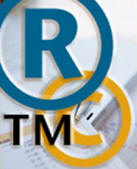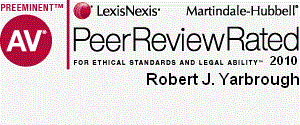Newsletter Issue 7 - September 2009
In this issue:
Is your patent vulnerable to foreclosure?
Sign, sign, everywhere a sign.
PTO Director Kappos to reform examiner 'count'
system
Congress considers copyright protection for
fashion designs.
Is your patent vulnerable to foreclosure?
by Robert J. Yarbrough
Patents are personal property, just like your car. Can your creditors foreclose on your patent? If you use your patent as collateral for a loan or create any other security interest in the patent and then default on the underlying obligation, the person holding the security interest in the patent can foreclose on the patent under state law and thereby acquire all rights in the patent.
The Federal Circuit Court of Appeals recently decided the case of Sky Technologies v SAP AG. In that case, a defendant in a patent infringement case argued that the plaintiff did not have the right to enforce the patent because the plaintiff acquired its ownership of the patent through a foreclosure sale, rather than by assignment. The Federal Circuit held that the person who acquired the rights in the foreclosure sale had the right to enforce the patent.
In short, a patent can have real value as collateral for a loan because a purchaser at a foreclosure sale can enforce the patent.
Trademark and copyright symbols.
by Adam Garson
Confused over when to use the appropriate symbol when referring to trademarks and copyrights? Here's the scoop.
The "C" in the circle is notice to the world that the associated work is protected by copyright law. Although not required by the Copyright Act, it may be placed on any published work. Registration of the copyright with the U.S. Copyright Office is not a prerequisite for placing the copyright notice on a work.
The "P" in the circle serves the same function as ©, however, it is reserved for published sound recordings.
Use of the the trademark ™ and service mark SM superscript symbols are not controlled by any federal law or regulation. Businesses typically use these symbols to indicate that they claim rights in the mark although the Patent and Trademark Office ("PTO") has not issued a registration. Because these symbols are not governed by federal trademark law, a pending trademark application is not a prerequisite for using them. Most important to understand is that use of these symbols does not confer any federal trademark rights.
The "R" in the circle indicates that the trademark is registered with the PTO. Although not required, the ® symbol may not be used before a registration has actually issued. When used, it should only be used on goods and services that are subject to a federal trademark registration and should be placed, when possible, directly following the trademark in superscript or in a smaller size than the trademark itself. Parenthetical use of the symbol is also permissible, e.g., (R). One does not have to use the trademark symbol with every appearance of the mark; however, it is good practice to use it when it first appears and where the trademark is prominently displayed.
Trademark users should exercise care in using the trademark registration symbol. Courts may impose liability for fraud, particularly if the user intended to mislead or deceive consumers by knowingly placing the symbol following a mark it does not own or following a mark, which is expired, cancelled or abandoned.
PTO Director Kappos proposes to reform patent examiner 'count' system.
by Robert J. Yarbrough
David Kappos, the newly-sworn Director of the U.S. Patent and Trademark Office ('PTO'), is moving quickly to place his mark upon the agency. In one of his first acts, Director Kappos launched an internal PTO task force to change fundamentally the way that patent examiners review patent applications.
At present, the PTO measures the productivity of patent examiners using piecework criteria known as the 'count' system. The 'count' system is crucial to examiners, who are evaluated, promoted or disciplined based on productivity. As currently implemented, the 'count system' drives arbitrary and wrong action on the part of patent examiners and unnecessarily costs patent applicants time and money.
An examiner earns a 'count' when the examiner issues a first office action and when the examiner disposes of an application. The productivity of each examiner is measured by how many 'counts' the examiner earns during each two-week period. The 'count' requirements are set so that the examiner has a very limited period of time to review an application. To meet his or her count requirements, the examiner has incentive to deny an application so that the applicant abandons the application (generating a 'count') or the applicant files a request for continuing examination (generating a 'count'). Although an examiner earns a 'count' for allowing a patent application, the allowed application is subject to a quality review by other PTO personnel and the examiner is subject to denial of promotion or other adverse consequences if the examiner erroneously allows too many patents.
Director Kappos stated that his goal is to provide examiners with enough time to review applications and to create incentives for efficient prosecution. We hope that Director Kappos is successful in meeting his goal and that incentives for arbitrary and wrong examiner decisions are eliminated.
Congress considers copyright protection for fashion designs.
by Adam Garson
Our office frequently receives calls from young entrepreneurs asking us to copyright their latest fashion design. Sadly, we tell them that copyright does not offer the protection they seek and, in fact, they will have to enter the market place with the expectation that their designs, if good enough, will inspire "knock off" copies.
This state of affairs may change, however, should the Design Piracy Prohibition Act (H.R. 2196) become law. The bill, which was introduced in April by William (Bill) Delahunt, U.S. Representative, Massachusetts's 10th District, offers copyright protection to fashion designs broadly defined as clothing, handbags, duffel bags, tote bags, and eyeglass frames.
The proposed legislation amends Chapter 13 of the Copyright Act, which offers design protection to a single category of useful articles, the design of boat hulls. Under current law, fashion designs are deemed "useful articles," defined by the Copyright Act as "an article having an intrinsic utilitarian function that is not merely to portray the appearance of the article or to convey information." 17 U.S.C. § 101.
Designs of useful articles can be protected under current copyright law "only if, and only to the extent that, such design incorporates pictorial, graphic, or sculptural features that can be identified separately from, and are capable of existing independently of, the utilitarian aspects of the article." Limited protection may be afforded by trademark (trade dress) and patent (design patents) law; however, these have not been practical alternatives for the fashion industry.
The proposed law provides only a three-year term of protection for fashion designs because fashion trends are typically short-lived. Other features of the bill provide that applications be filed with the U.S. Copyright Office, which would be required to maintain a publicly accessible, computerized database of protected fashion designs, including images. The bill makes protection unavailable for fashion designs that have been made public by the designer more than six months before the application for registration. It also narrows the definition of "innocent infringement" to impose liability for those who had a reasonable grounds to believe that design protection was claimed; and increases damages for infringement.
Keep in mind that Congress' previous attempts at providing copyright protection for fashion designs have been largely unsuccessful. We'll keep you informed of the progress of this bill.

